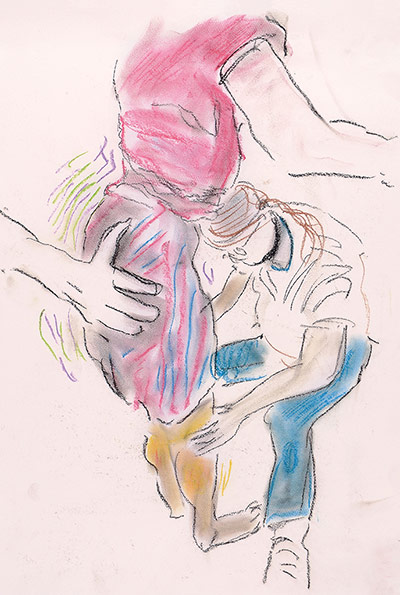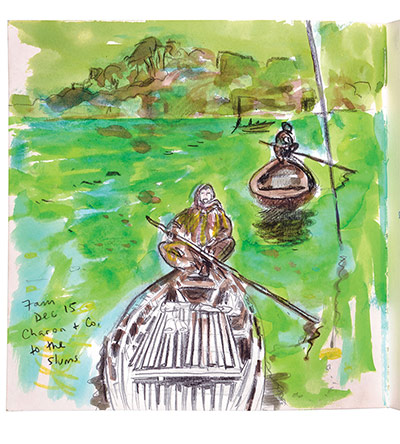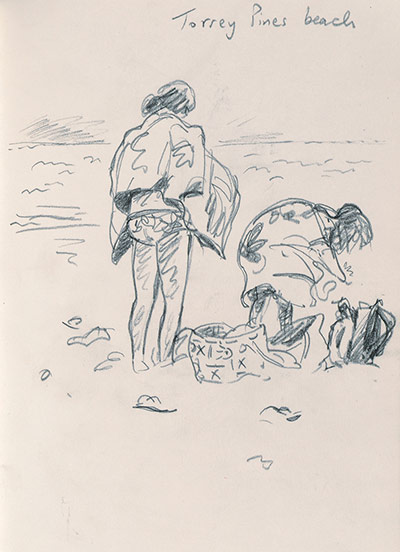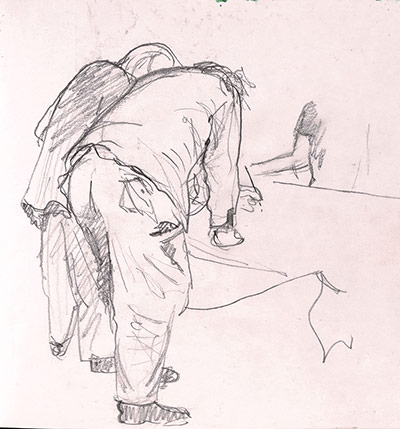
'An embarrassing drawing of a slightly humiliating moment – scary, not humiliating – where I was terrified about whether I’d be able to walk again, whether I’d be shaking all over, not able to put my foot down. The art therapist at Charing Cross hospital persuaded me to do this and brought in some chalks. It was helpful. It was me saying: “I know what’s happening to me and I can look at it full frontal and think about it and comment on it, almost.” I’m a passive object looking at myself as a passive object, I guess. That’s the best way I can explain it' Photograph: Andrew Marr

'The colour of that water is accurate. It is a thick, chemical, poisonous green. That’s first thing in the morning. It must look like Venice looked in about 900AD: in other words, you can see what all the supports are like, and you’ve got rickety collapsing latrines pouring their contents into the water. At some level, it is rather beautiful but it is beautiful in a horrific way. I think drawing makes you less arrogant. It makes you more open to what you’re drawing. You have to give attention and love to an object or scene that you might otherwise walk past or ignore' Photograph: Andrew Marr

'This is the only oil painting in the book. The great thing about trees is that they are as individual as people. I think trees have a very interesting psychic relevance to us somehow – their size, shape, individuality, ubiquity. When I’m concentrating on drawing, I find I’m only thinking about what I’m doing and that time just vanishes. Everything inside my head is, as it were, cleansed by what I’m doing. I’m more conscious of what’s immediately around me and not all the rubbish of meetings and political speeches and stuff that is normally rattling around my head' Photograph: Andrew Marr

'A very very quick drawing. So those are my two daughters, just drying off after being in the sea in America. You can take photographs of your children on the beach, and everyone does. But for me, the difference between this and a photograph is that I spent time on it. I can suck back in some of that: even now, I remember that moment. I was standing up in a brisk wind. The thing about a photograph is that it’s a mechanical action. A drawing’s all about the size of your hand, your fingers, your memory and therefore it’s much more emotional' Photograph: Andrew Marr

'This is a drawing of [Guardian cartoonist] Steve Bell from behind – and I maintain that it captures a bit of the essence of Steve Bell that a full-frontal beardy photograph wouldn’t get you. There is Steve Bell actually doing what he does and you get, I think, a good sense of the physicality of the man actually engaged and completely concentrating' Photograph: Andrew Marr

'The reason I included this is that I do believe we should be able to draw what appear to be very banal things: plastic bottles and cereals packets, plastic bags and towels, as well as landscapes and trees. The iPad is very good for texture. Though I have to say I’ve had a disaster with mine. I go on and on about how wonderful it is, but I should say that, after the stroke, I went back in and forgot my password, and it locked me out. So I’ve lost all my pictures on the iPad. I’m cross with it at the moment' Photograph: Andrew Marr

'This was in a tiny, very good museum of Nazca art in Peru. The thing about the Nazca is they’re roughly speaking the same era as the Vikings: they were an extraordinarily interesting culture but they misunderstood their own ecosystem. They tore up the trees supporting their valleys and they died out. But because it’s so dry there, many of their bodies were preserved. For a long time, mummified Nazca people were all around the city. But it’s pretty horrific when they’re put in a museum in a glass case. That was what this drawing was trying to convey' Photograph: Andrew Marr

'The main rubbish tip in Dhaka, Bangladesh: it’s both horrific and a very interesting poltical phenomenon. Everything is re-used except a thin disgusting sludge that sticks to everything. Any piece of plastic, any button, any bottletop – everything is reclaimed and used for something else. So these are people picking the last bits off the carcass. The stench was unbelievable: the clouds of flies – in terms of places to draw, that’s about as bad as it gets' Photograph: Andrew Marr

